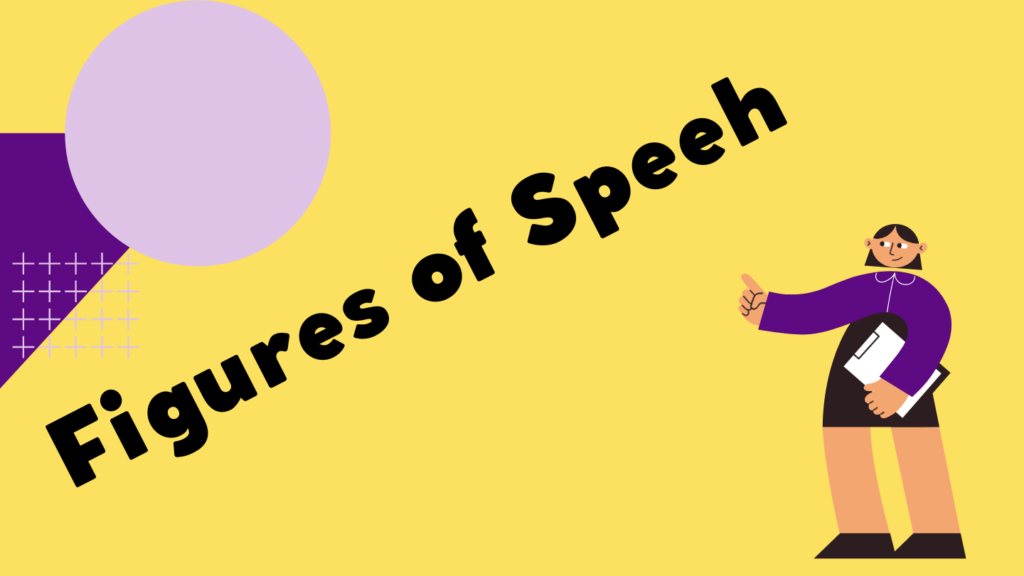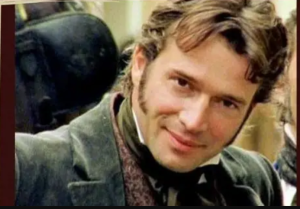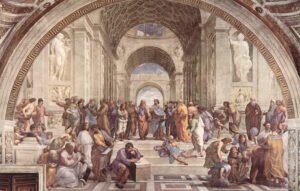21 Types of Figures of Speech
Figures of speech are poetic devices which consist in the use of words and phrases in such a manner as to make the meaning more pointed and clearer and the language more graphic and vivid. Figures are also called images for in them one thing is represented in the image of another. Figures of speech add beauty to the language, hence called figurative language.

The most important figures of speech are Simile; epic or Homeric Simile; Metaphor; Personification; Pathetic Fallacy; Apostrophe’; Hyperbole; Metonymy; Synecdoche; Oxymoron; Antithesis; Onomatopoeia; Alliteration; and Transferred Epithet. Use of such figurative language makes poetry fun for reading and listening.
1. Simile
A simile is an expression of likeness between different objects or events. There is always a word of comparison between the two unlike objects or events. Such words of comparison as, like, as, so, etc., are always used. For example:
(a) Errors like straws upon the surface flow.
(b) The younger brother is as good as gold
2. Epic or Homeric Simile
Named after Homer, Epic simile is also called the long-tailed simile because the comparison is not confined to one quality but a number of qualities are compared and the comparison is elaborated and spread over a number of lines.
3. Metaphor
A metaphor is implied simile. It is a compressed, or implied simile—simile without the word ‘like’, ‘as’ etc. For example:
(a) The came is the ship of the desert.
(b) He is the pillar of the state.
4. Personification
It is a figure of speech in which inanimate objects and abstract ideas or qualities are spoken of, as if they were persons or human beings.
Examples of personification are:
(a) Opportunity knocks at the door but once.
(b) Death lays his Icy hands on kings (c) Peace hath her victories No less renowned than war.
In all these instances, life and intelligence have been imparted to lifeless objects or abstract Ideas.
5. Pathetic Fallacy
Pathetic Fallacy is a figure of speech in which human emotions are given to lifeless objects and abstract ideas. For example:
All Nature wept at his death, and the Flowers were filled with tears.
6. Apostrophe
The word literally means a ‘turning aside’, for in this figure a writer turns aside’ to address a person absent or dead, or an inanimate object, or an abstract idea.
For example:
(a) “O wild west wind, thou breath of Autumn’s being.”
(b) “O Solitude, where are the charms
That sages have seen in thy face”?
7. Hyperbole
The word “hyperbole” (“Hyper”—beyond; “ballo”-throw) literally, “a throwing beyond”, means exaggeration. This figure of speech consists in representing things as much greater or smaller than they really are. For example:
Here’s the smell of the blood still. All the
perfumes of Arabia will not sweeten this little
hand. Oh, oh, oh,
8. Metonymy
The word “metonymy”, means “substitution of name”, and the figure consists in “substituting the thing named for the thing meant”; for example, grey hair may be used for old age, throne for monarchy. Some other examples are:
(a) The pen (author) is mightier than the sword (the soldier). (b) Sceptre and Crown
Must tumble down,
And in the dust be equal made
With the poor crooked scythe and spade.
9. Synecdoche
This figure of speech is really a special form of metonymy. Its name ‘syn—with, ekdoche’—succession, means literally, “the understanding of one thing by another”. In the figure there is the substitution of a part for the whole and vice versa, OR of an abstract noun for a concrete one and vice versa, OR of an individual for a class, and vice versa, OR of the name of the material of which a thing is made for the name of the thing itself. For example:
(a) The rank and file streamed out of the city to see the sight. (b) There is a mixture of the tiger and the ape in his character.
(c) Ronaldo is the Pele’ of present day world of football.
(d) He gave the beggar a few coppers
(e) Jack got some new wheels!
Similarly, The Pentagon is the United States Department of Defense, and Downing Street or Number 10 for the office of the Prime Minister of the United Kingdom.
10. Oxymoron
An oxymoron is the association or bringing together of two words or phrases having opposite meanings. For example:
(a) “James I was the wisest fool in Christendom.” (b) “That time is past
And all its aching joys are now no more,
And all its dizzy raptures.”
11. Antithesis
An antithesis, ‘anti’—against; ‘thesis’—placing, is a figure of speech in which one words or idea is set against another to height the effect of what is said by contrast. For example:
(a) “God made the country but man made the town.” (b) “United we stand divided we fall.”
(c) “Speech is silvery, silence is golden.”
12. Onomatopoeia
Onomatopoeia, (‘onoma’—name; ‘poiea’—make,) is the use of a word or words whose sound itself conveys the sense. Examples of onomatopoeia are:
(a) “It cracked and growled and roared and howled
like noises in a swound.”
(b) “The murmurous haunt of flies on summer eves.”
13. Epigram
A brief pointed saying expressing antithetical ideas, or exciting surprise, is called Epigram. For example:
(a) The child is father of the man. (b) Art lies in concealing art.
14. Irony
It is the figure of speech in which the real meaning is just the opposite of that which is literally conveyed by the language used. For example:
Here, under leave of Brutus, and the rest,
(For Brutus is an honourable man)
I come to speak in Caesar’s funeral.
Here the use of the word, “honourable’ is ironical.
15. Pun
When we use the same word in two or more senses in order to make the people laugh, we employ the Figure of Speech called Pun.
An ambassador is a gentleman who lies abroad for the good of his country,
Here there is a pun on the word ‘lies.
16. Alliteration
Alliteration consists in the repetition of the letters or syllable, or the same sound at the beginning of two or more words in a line. In this way language becomes musical. For example:
(a) How high His Honour holds his haughty head. (b) “The fair breeze blew,
The white foam flew,
And the furrow followed free.
We were the first to ever burst into that silent sea.”
17. Transferred Epithet
In this figure of speech an epithet or qualifying adjective is sometimes transferred from a person to an object or from one word to another. For example:
(a) “The ploughman homeward plods his weary way”
(b) “He tossed from side to side on his sleepless bed.”
And the furrow followed free.
We were the first to ever burst into that silent sea.”
In the first case weary has been transferred from the ploughman to the way; in the second case sleepless has been transferred from He to bed.
18. Litotes
Litotes use a double negative to create a positive.
Example: You’re not going in the wrong direction.
19. Paradox
A paradox is a statement that appears to contradict itself but contains some truth, theme, or humor.
Example: “All animals are equal, but some animals are more equal than others.” Nobody goes to the anymore — it’s too crowded. This statement is a lie. (self contradictory)
20. Euphemism
A euphemism is a way of saying something in an modest manner, often to avoid difficult topics—like money, death, or sex.
Example: Death can be a painful subject, so we use euphemisms to avoid confronting it head-on. Instead of telling a friend that a relative died, we might say that they” “passed away,” or are “no longer with us.”
21. Allegory
An allegory (AL-eh-goh-ree) is a story within a story. It has a “surface story” and another story hidden underneath.
For example, the surface story might be about two neighbors throwing rocks at each other’s homes, but the hidden story would be about war between two countries.
#Figures of speech #Figures of speech #Figures of speech #Figures of speech #Figures of speech #Figures of speech #Figures of speech #Figures of speech #Figures of speech #Figures of speech #Figures of speech
Read More
Introduction to Fiction and Non Fiction
Of Death — Francis Bacon (Text)
Of Truth Critical Analysis by Sir Francis Bacon
Of Truth by Francis Bacon Summary
Visit Us on our Facebook Page:





